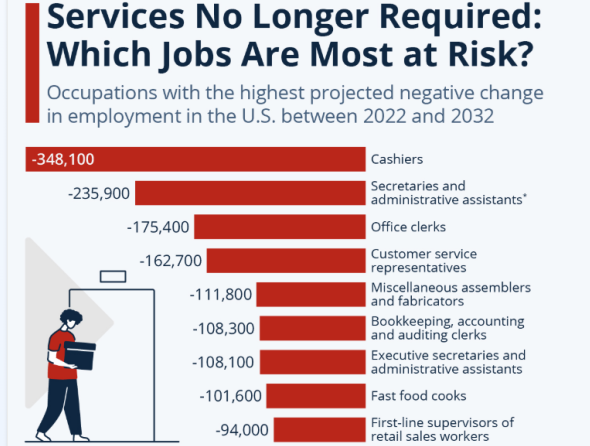
The American job market is witnessing unprecedented shifts, with some of the fastest declining jobs disappearing at alarming rates. In fact, the tobacco manufacturing industry faces a dramatic 53.3% employment decrease between 2022 and 2032, marking it as the most rapidly declining sector in the United States. While the overall U.S. employment is projected to grow by 4% from 2023 to 2033, several traditional industries are experiencing significant contractions. We’re seeing substantial workforce reductions across multiple sectors. The manufacturing and optical media industry projects a 50.4% decline, while apparel and leather manufacturing expects to lose 41,800 jobs – a 36% reduction. Similarly, the printing industry anticipates shedding 96,800 positions, and the coal mining sector faces a 26% decline with 9,500 job losses. As a result, workers in these declining industries must prepare for significant career transitions in the coming years.

BLS Reports Manufacturing Jobs Face Steepest Decline
Manufacturing employment in the United States has experienced a dramatic decline over the past four decades. At its peak in June 1979, manufacturing jobs represented 22% of total nonfarm employment with 19.6 million workers . Subsequently, this number plummeted to 12.8 million by June 2019, marking a 35% decrease .
Tobacco Manufacturing Loses Over 50% WorkforceThe tobacco manufacturing sector exemplifies this downward trend. Reynolds American Inc., a major tobacco manufacturer, reduced its workforce by 10.7% in 2022 alone . Furthermore, the company’s total workforce decreased by 22.3% from approximately 5,500 employees in December 2016 . Notably, technological advances have significantly reduced labor demand in both farming and manufacturing sectors .
Automation Displaces Factory Workers
Automation continues to reshape the manufacturing landscape, primarily affecting workers with lower education levels who perform routine tasks . Research estimates indicate that between 9% and 47% of jobs could face automation in the future. Additionally, automated machines create a distinct pattern of impact:
Generate positive effects for R&D and technical staff
Show minimal impact on sales positions
Produce negative consequences for production, administrative, and financial staff
Consequently, workers impacted by automation require new skills to adapt. The Department of Labor identifies three critical skill categories for in-demand jobs: interpersonal abilities, process skills for quick knowledge acquisition, and specific technical expertise .
Global Competition Intensifies Job Losses
The integration of the United States into the global economy has intensified manufacturing job losses. Between 2001 and 2018, the growing trade deficit with China alone displaced 3.7 million U.S. jobs, including 2.8 million manufacturing positions . Furthermore, the manufacturing sector witnessed the elimination of nearly five million jobs between 1998 and 2019. The competitive dynamics have particularly affected small and medium-sized enterprises. Primarily, U.S. manufacturing productivity growth remains substantially below Germany’s best-in-class standards . Moreover, many U.S. small and medium-sized enterprises struggle to compete with the cost advantages of Chinese manufacturers . The manufacturing decline has disproportionately impacted workers of color. Between 2001 and 2011, the growth of the trade deficit with China displaced 958,800 jobs held by workers of color, representing 35.0% of total jobs displaced . The Black share of manufacturing jobs, which peaked at 10.6% in 1992, declined to 10.2% by 2020, despite Black workers making up 12.3% of all workers .
AI Technology Eliminates Traditional Office Roles
Artificial Intelligence continues to reshape traditional office environments, with data processing and administrative roles facing substantial declines. According to recent employment data, 19% of American workers currently hold positions most exposed to AI implementation .
Data Entry Positions Decrease by 26%
Data entry keyers face one of the most dramatic workforce reductions, with employment projected to fall from 163,900 to 122,800 positions . First of all, automation already reduces manual data entry work by 80% across industries .Presently, the largest employers of data entry professionals include:
Employment services with 22,000 workers
Computing infrastructure providers
Accounting and payroll services
Educational institutions
Management consulting firms
Administrative Assistants Face 20% Reduction
Office and administrative support roles have lost over 2 million positions between 2016 and 2021 . Financial clerks and secretaries experienced the steepest declines, with positions dropping by 10.3% and 8.7% respectively . In contrast to traditional roles, integrated calendar systems and automated office management tools now handle many administrative tasks previously managed by assistants . The transformation extends beyond basic task automation. Currently, AI-powered systems manage various office functions, including project planning, meeting transcription, and automated minute-taking . These technological advances enable organizations to streamline workflows while reducing costs . According to workplace surveys, 59% of employees using AI tools report greater job satisfaction . This indicates that rather than completely eliminating positions, AI often augments human capabilities. The technology primarily automates routine tasks, allowing workers to focus on more strategic responsibilities . The impact varies across different administrative roles. Payroll and timekeeping clerks project a 15.1% decline, new accounts clerks face a 14.6% reduction, and tellers anticipate a 14.7% decrease in positions . These changes reflect a broader shift toward digital transformation in office environments, where AI-driven solutions increasingly handle routine administrative tasks .Print Media Industry Witnesses Massive Layoffs Print media organizations face severe workforce reductions as traditional publishing models struggle to remain viable. The Washington Post eliminated 4% of its workforce after losing USD 77 million in 2023 . Initially, the Associated Press announced plans to cut 8% of its staff positions
Newspaper Publishers Cut 24% Jobs
The news industry witnessed at least 3,875 redundancies and layoffs across newspaper, broadcasting, and digital media businesses in 2024 . Specifically, the first quarter saw 1,576 job cuts, followed by 300 in Q2, 887 in Q3, and 1,112 in Q4 . Major publishers implemented multiple rounds of reductions:
Time Magazine
Wall Street Journal
Bustle Digital Group
Hearst Magazines (192 positions across editorial, sales, and PR)
Digital Transformation Forces Career Changes
The print industry faces fundamental shifts as digital communication dominates corporate strategies . Currently, print operations become integrated into digital workflows, affecting traditional roles . Employment in printing and related support activities has declined 57% since 2001 . The Bureau of Labor Statistics projects an 18% decrease in printing industry employment between 2023 and 2033 . This decline stems from market share losses to other media formats and increased automation . Primarily, the transformation requires print workers to adapt to new technical requirements and digital processes.
Print Workers Seek New Opportunities
About one in five newspapers have closed, based on research from the Hussman School of Journalism and Media . The remaining publications operate with significantly reduced newsroom staffs . For instance, several prominent journalists recently transitioned to different outlets – Ashley Parker and Michael Scherer moved to The Atlantic, while Josh Dawsey joined The Wall Street Journal . The industry’s transformation creates opportunities through replacement openings as workers transfer to other occupations. Ultimately, successful transitions require workers to develop new skills aligned with digital media demands. The shift affects various roles, from editorial positions to production staff, as companies adapt their business models to meet changing market conditions .
Coal Mining Industry Shrinks as Green Energy Grows
Coal mining employment faces a fundamental shift as the industry confronts unprecedented challenges. U.S. coal mining jobs plummeted from 92,000 in 2011 to 54,000 in 2018 , marking one of the fastest declining jobs in the American economy.
44% Mining Jobs Disappear by 2030
The coal sector’s contraction continues at an accelerated pace. Current employment stands at 43,582 jobs, with 32,090 positions east of the Mississippi River and 11,434 jobs in the western region . Evidently, the decline stems from multiple
factors:
Technological advances in natural gas production
Environmental regulations under the Clean Air Act
Railroad deregulation impacts
Automation and productivity improvements
Labor productivity in coal mining has risen substantially, from 5.2 tons per labor hour in 2011 to 6.2 tons in 2018 .
Primarily, this increase results from the adoption of less labor-intensive longwall and highwall mining systems .
Communities Face Economic Transformation
The ripple effects of coal industry decline essentially reshape entire communities. In Boone County, West Virginia, local government funding decreased by half within five years due to coal mine closures [4]. The impact extends beyond direct job losses:
The Economic Development Administration (EDA) now administers the Assistance to Coal Communities Program to support affected regions . Through this initiative, the government allocated more than USD 300 million to help coal communities recover from economic challenges .
The Biden Administration’s commitment to eliminate conventional coal generation by 2030 [2] necessitates comprehensive
support for affected workers and communities. The Department of Energy’s transition programs focus on:Regional economic growth and diversification
Creating new employment opportunities
Supporting displaced coal economy workers
The National Association of Counties received a USD 2.6 million grant to lead the Building Resilient Economies in Coal Communities Initiative . This program aims to develop sustainable economic alternatives for coal-dependent regions. The transition poses unique challenges for coal communities, where mining jobs traditionally provided wages between USD 35-50 per hour . The renewable energy sector offers potential employment alternatives, with solar and wind technician jobs projected to grow 11 to 13 times faster than the U.S. average .
Workers Navigate Career Transitions Successfully
Successful career transitions emerge as a beacon of hope for workers affected by declining industries. The U.S. Department of Labor’s Employment and Training Administration actively supports job seekers through comprehensive programs
designed to enhance employability and earnings .
Skills Assessment Guides New Paths
Career assessments serve as crucial tools for workers seeking new directions. Above all, these evaluations help individuals identify work-related interests and match them with suitable occupations . The Career Cruising database offers two primary assessment tools:
The Matchmaker and My Skills Assessment
The Learning Styles Inventory
Primarily, these tools analyze individual preferences and learning styles to suggest career paths aligned with personal strengths. The O*NET Interest Profiler, coupled with vocational assessments, helps workers create accurate profiles of their professional interests .
Training Programs Open New Doors
The American Job Center network delivers tailored training programs across states, adapting to local economic needs [3]. At
this point, the Employment and Training Administration funds various initiatives focusing on:
The Michigan Career & Technical Institute, one of the country’s largest rehabilitation training centers, demonstrates the scope of available opportunities. The institute provides post-secondary vocational and technical training, particularly supporting adults with disabilities . Nevertheless, the World Economic Forum projects that nearly half of all jobs will require reskilling by 2025 . Under those circumstances, the Department of Labor has established multiple pathways for skill development. Workers can access training opportunities through CareerOneStop and mySkills myFuture websites, which help bridge skill gaps between previous and future employment .
Success Stories Inspire Hope
Real-world examples highlight the potential for successful transitions. Sooner or later, many workers discover unexpected opportunities through strategic career shifts. For instance, a former Macy’s store manager successfully transitioned to an entry-level publishing role, launching a new writing career . Another notable success story features a fast-food worker who entered an entirely new industry through a chance encounter . Similarly, a former teacher discovered coding aligned with her problem-solving skills, leading to a successful technology career transition .
The Michigan Works! Southwest program exemplifies effective transition support, offering scholarships for workers seeking new skills in high-demand fields . The program assists with on-the-job training, skills upgrading, and occupational training, focusing on sectors such as:
Agriculture
Energy
Healthcare
Information technology
Manufacturing
The KAMA program provides a 4½-week manufacturing employee training course, combining production assembly training with college-level classes in essential skills . Upon completion, Career Coordinators assist students with job placement, offering the program at no cost through grant funding .
Government Launches Support Programs
Federal and state governments have launched comprehensive support programs to assist workers affected by rapidly declining industries. The Career Transition Assistance Plan (CTAP) provides selection priority to qualified federal employees who receive notices about job elimination .Retraining Initiatives Target Displaced Workers
The Employment and Training Administration (ETA) manages core programs that deliver career and training services through approximately 2,400 American Job Centers nationwide . These centers provide:
Job search assistance and workforce preparation
Career development services
Classroom-based learning opportunities
Work-based training programs
Tailored business services
Primarily, the National Emergency Grants expand service capacity at state and local levels . Throughout the transition process, on-site services offer pre-layoff and retraining information to ease the shift from notification to shutdown . The Colorado Office of Just Transition demonstrates state-level commitment by helping communities retain family-sustaining jobs while increasing economic diversity . Currently, the program assists coal industry workers in transitioning to new careers, relocating, or retiring based on individual circumstances .
Indeed, the Employment and Training Administration recognizes that training must align with business and industry needs . The public workforce system offers training for unemployed or underemployed individuals, focusing on high-growth, high-demand occupations .
Financial Aid Helps Career Shifters
The Department of Education has allocated substantial resources to support career transitions. In 2020, they proposed $1.1 billion for Career and Technical Education State Grants and over $600 million for Adult Education state grants . Individual Training Accounts enable workers to pay for short-term training needed for labor market advancement . Otherwise, longer-term training becomes available for workers laid off due to foreign trade impact . The Trade Readjustment Allowances provide income support to individuals whose jobs were affected by foreign imports . Unemployment insurance serves as a crucial safety net during transitions. Generally, states require qualified applicants to:
Have earned a minimum amount within 12-24 months
Demonstrate consistent work history
Actively seek new employment
The Consolidated Omnibus Budget Reconciliation Act (COBRA) certainly helps qualified workers maintain their group health insurance during eligibility changes . Additionally, the Self-Employment Assistance program offers dislocated workers opportunities for early re-employment . Ultimately, the Department of Labor permits significant flexibility for states to amend their unemployment insurance laws. This adaptability allows benefits payment in various scenarios, including temporary business closures and quarantine situations .
The Woodrow Wilson National Fellowship Foundation exemplifies targeted support, offering a $30,000 stipend for career changers with science and math backgrounds to become teachers . Furthermore, thousands of scholarships remain available for individuals seeking career changes, with approximately 90% of awards having no restrictions on degree type.
Conclusion
All things considered, the American job market faces unprecedented changes across multiple sectors. Manufacturing jobs, particularly in tobacco and apparel, show the steepest declines, while AI technology reshapes traditional office roles. Print media and coal mining industries also experience significant workforce reductions, affecting thousands of workers nationwide. Consequently, career transitions become essential for affected workers. Success stories demonstrate that strategic shifts to growing sectors offer viable paths forward. Above all, government support programs provide crucial assistance through retraining initiatives and financial aid. The comprehensive network of American Job Centers, coupled with various federal and state programs, helps workers acquire new skills aligned with emerging job markets. The transformation of traditional industries, therefore, presents both challenges and opportunities. Workers who embrace change and utilize available resources position themselves for success in evolving job markets. Ultimately, the key lies in identifying transferable skills, pursuing relevant training, and leveraging government assistance programs to navigate career transitions effectively.






